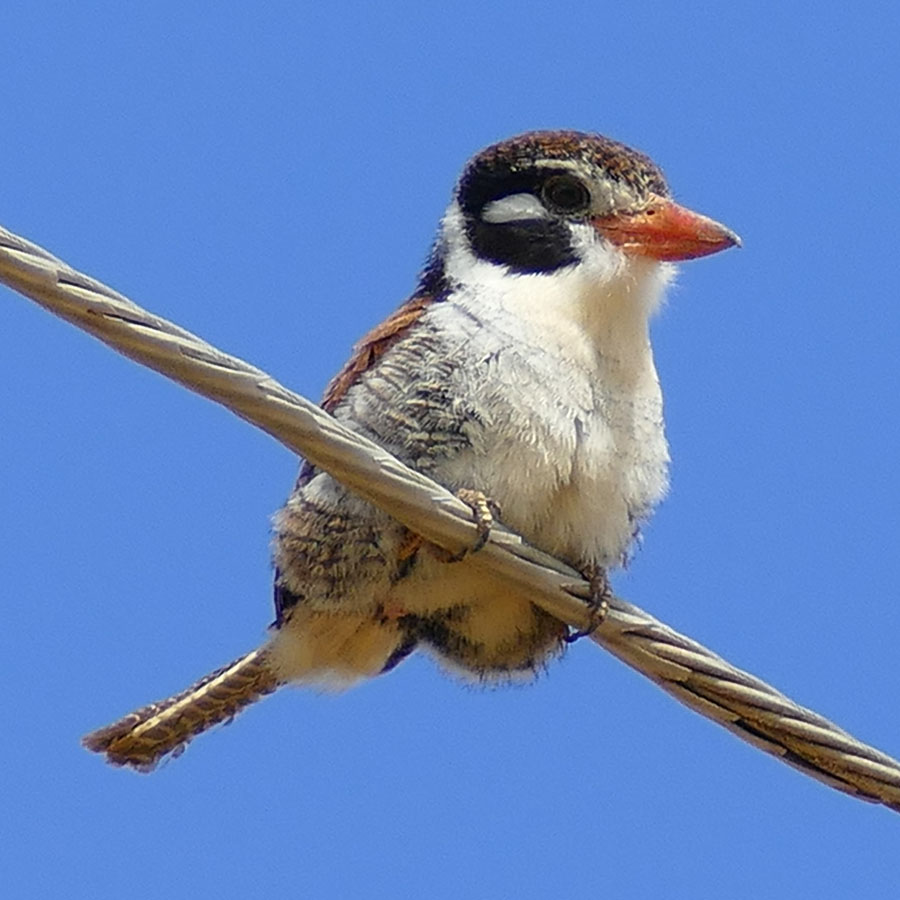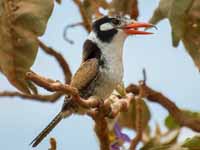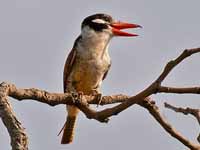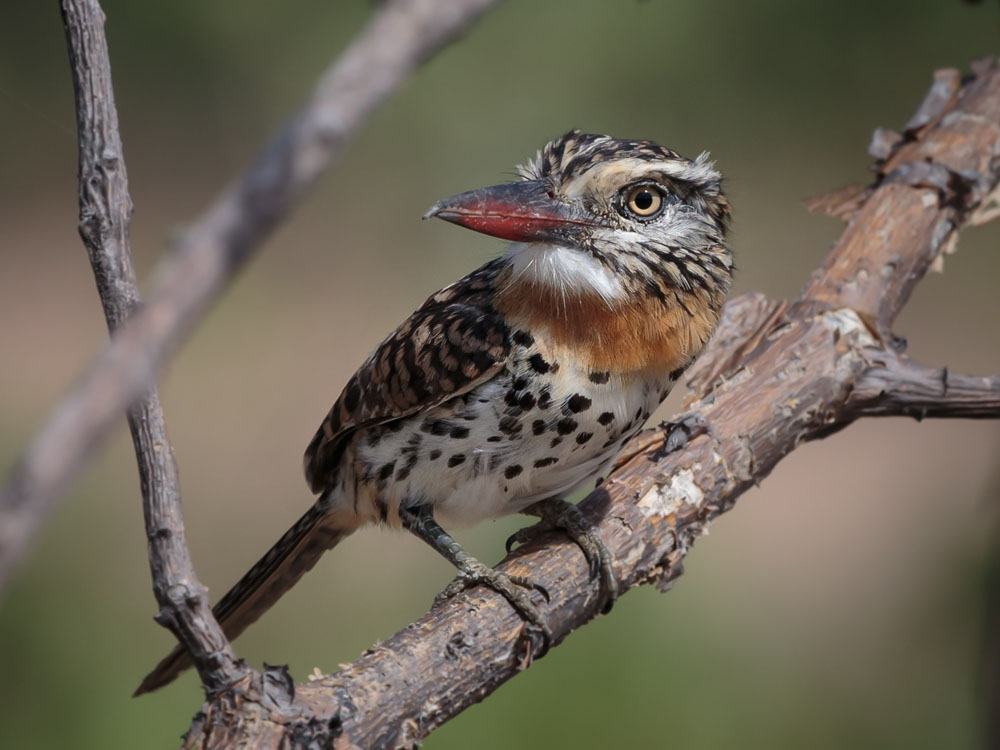The order Piciformes is made up of the woodpecker family Picidae plus 8 other families. Picidae make up about half of the species. In general, the Piciformes are insectivorous, but some exceptions eat mostly fruit. Nearly all Piciformes have parrot-like feet—two toes forward and two back, an arrangement that has obvious advantages for birds that spend much of their time on tree trunks. And most Piciformes do not have down feathers at any age, only true feathers. All nest in cavites.
The puffbirds and their relatives are tropical found in South America. They have large heads and thick flattened bills with a hooked tip. The loose abundant plumage and short tails makes them look stout and puffy, giving rise to their name. They feed on insects, centipedes, millipedes, scorpions, spiders, cockroaches, mantises, grasshoppers, beetles, and lizards. They catch their prey by a watch and wait technique. They are noted for perching motionless for long periods of time which conserves energy and does not alert their prey. Their eyesight excellent enabling them to spot a green insect in green foliage 20 meters away. They have varied nesting techniques:arboreal termite mounds, rotting stumps, a ground scrape which is covered with twigs and leaves, or a tunnel over a meter long. They have 2 to 3 glossy white eggs.
The smallest puffbirds are the nunlets of genus Nonnula. They have lengths from 14 to 15 cm and weigh between 15 and to grams.
The nunbirds of genus Monasa are larger than typical puffbirds, have a more slender appearance, and proportionately longer tail and smaller head. They are 25 to 29 cm long and weigh 40 to 100 grams. They have grey or black plumage which leads to their nunbird names. Insects are their main found and they are captured by sallies from a perch. They occur in or near thick forests from Nicaragua to Brazil. Their nest tunnels are over a meter long. Nunbirds. the most social of puffbirds, sometimes sing together as a ground. Also, older siblings may help raise the young.
The puffbirds are closely related to the jacamars, another Neotropical family, and the two families are sometimes separated into their own order, Galbuliformes, separate from the Piciformes.
Genus Bucco
The bucco puffibrds vary from 14 to 20 cm in length. They create a nest-cavity in in an aboreal termite mound.
Puffbird,_Chestnut-capped Bucco macrodactylus
Description: The chestnut-capped puffbird has brown upperparts, a chestnut cap, reddish-orange half collar on the nape, a black half-collar above the breast, and a wide black band just below the eyes. It has a dull whitish upper-breast with the rest of the underparts buffy. The bill and legs are black. The chestnut-capped puffbird is 14 to 16 cm long. It creates a nest-cavity in in arboreal termite mound.
Range: Bolivia, Brazil, Columbia, Ecuador, Peru, Venezuela.
Habitat: Many forest types, but typically near water.
Diet: Insects on vegetation which it captures from a perch.
Conservation status: Least Concern.
Image by: 1) jester625honor 2) Nick Athanas - Ecuador 3) Oscar_Marin-GomezRange: Bolivia, Brazil, Columbia, Ecuador, Peru, Venezuela.
Habitat: Many forest types, but typically near water.
Diet: Insects on vegetation which it captures from a perch.
Conservation status: Least Concern.

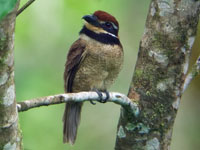

Puffbird,_Collared Bucco capensis
Description: The collared puffbird has dark rufous upperparts and head. Its rump is lighter rufous and the tail is orange-chestnut with narrow black bars. There is a distinct black collar with white above it plus a white throat. The rest of the underparts are mainly white with orange flanks and vent. It has an orange eye-ring and bill. The collared puffbird is about 19 cm long. It creates a nest-cavity in in aboreal termite mound or sometimes a rotting stump.
Range: Northern Brazil and the bordering countries.
Habitat: Forests.
Diet: Lizards, snakes, frogs, large insects, It forages from a perch to obtain its prey from foliage or the forest floor.
Conservation status: Least Concern.
Image by: 1) Nick Athanas - Ecuador 2) Patko_Erika 3, 4) thibaudaronsonRange: Northern Brazil and the bordering countries.
Habitat: Forests.
Diet: Lizards, snakes, frogs, large insects, It forages from a perch to obtain its prey from foliage or the forest floor.
Conservation status: Least Concern.
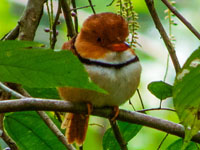
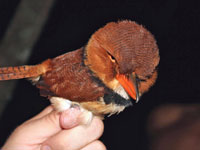
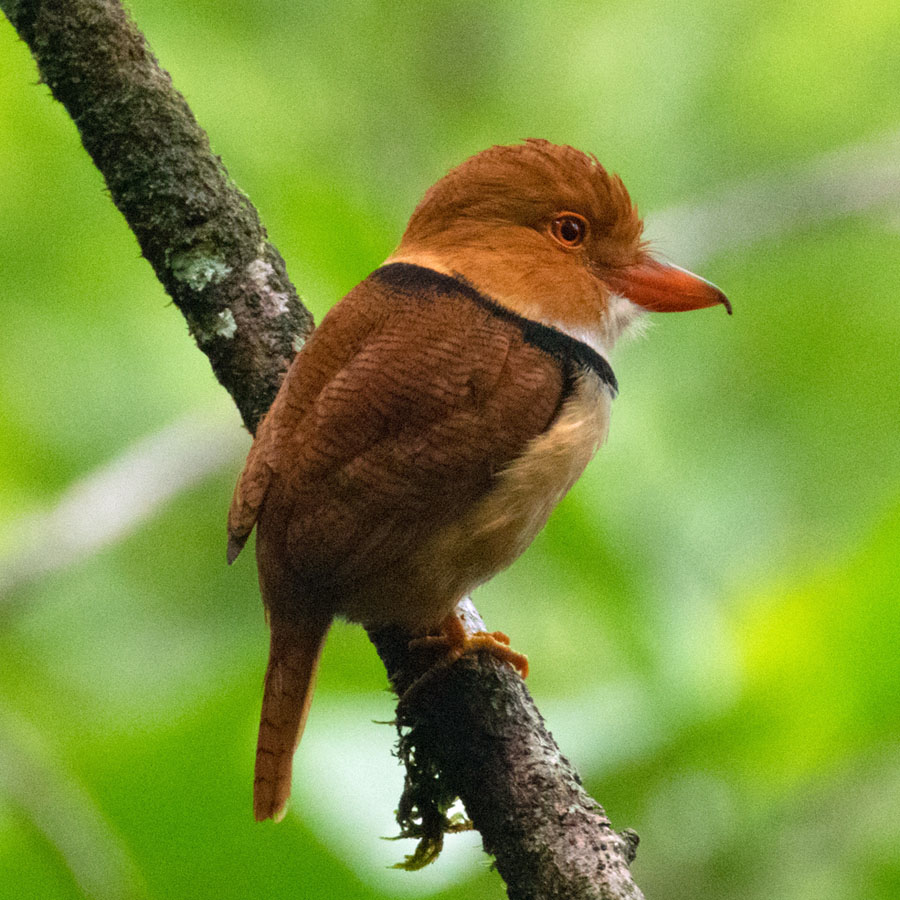
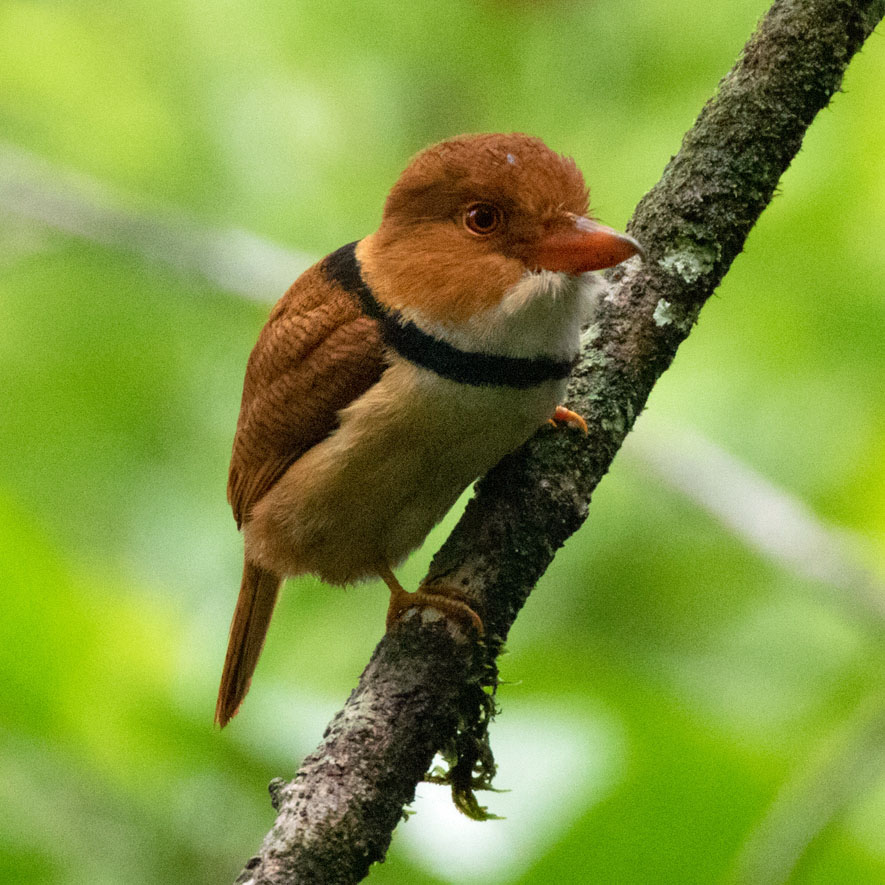
Puffbird,_Sooty-capped Bucco noanamae
Description: The sooty-capped puffbird has sooty upperparts including its cap. The throat and supercilium are white. It has a broad black breast-band, a white lower-breast, and a white belly with black spots and / or black barring. The sooty-capped puffbird is 18 cm long. It creates a nest-cavity in in arboreal termite mound. The sooty-capped puffbird is closely related to the spotted puffbird.
Range: Columbia.
Habitat: Secondary forests, scrublands. It is found less than 100 m of elevation, low in vegetation.
Diet: Sallies from a low perch to pluck large insects from foliage.
Conservation status: It is listed as Near Threatened as its population is declining due to loss of habitat.
Image by: 1, 2) Diego CalderonRange: Columbia.
Habitat: Secondary forests, scrublands. It is found less than 100 m of elevation, low in vegetation.
Diet: Sallies from a low perch to pluck large insects from foliage.
Conservation status: It is listed as Near Threatened as its population is declining due to loss of habitat.
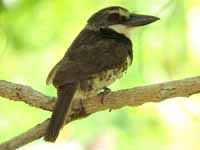
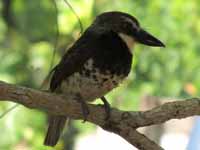
Puffbird,_Spotted Bucco tamatia
Description: The spotted puffbird has dark brown upperparts with some buff edging on the mantle. It has a chestnut cap, rufous forehead, black neck patch, white throat, and a rufous fore-collar. The underparts are white with black spots. The spotted puffbird is about 18 cm long. It creates a nest-cavity in in arboreal termite mound.
Range: Bolivia, Brazil and to the north.
Habitat: Forest, forest borders, second growth, wood savanna.
Diet: Insects, other invertebrates such as spiders and scorpions, small lizards. Also mistletoe berries. Sallies from a low perch to pluck large insects from foliage or bark.
Conservation status: Least Concern.
Image by: 1) Tony Morris 2, 3) Nick Athanas - Guyana, BrazilRange: Bolivia, Brazil and to the north.
Habitat: Forest, forest borders, second growth, wood savanna.
Diet: Insects, other invertebrates such as spiders and scorpions, small lizards. Also mistletoe berries. Sallies from a low perch to pluck large insects from foliage or bark.
Conservation status: Least Concern.
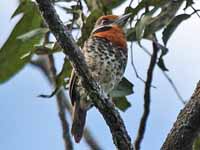
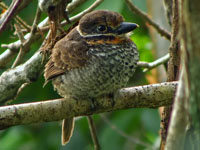
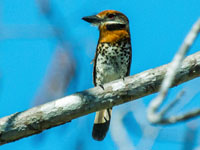
Genus Chelidoptera - 1 species
Puffbird,_Swallow-winged Chelidoptera tenebrosa
Description: The swallow-tailed puffbird has mainly dark blue or blackish plumage. The belly is rufous and the rump white. Its small bill is atypical for a puffbird as are the long pointed wings. The swallow-tailed puffbird is 14 to 15 cm long. The nest-cavity is constructed in a sandy or earth banking.
Range: Bolivia, Brazil and to the north.
Habitat: Open areas with scattered bushes, forest edges.
Diet: Insects which it catches in flight from a perch in a tree.
Conservation status: Least Concern.
Image by: 1, 2) Claudio Timm - Brazil 3, 4) Nick Athanas - Columbia, BrazilRange: Bolivia, Brazil and to the north.
Habitat: Open areas with scattered bushes, forest edges.
Diet: Insects which it catches in flight from a perch in a tree.
Conservation status: Least Concern.
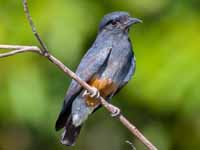


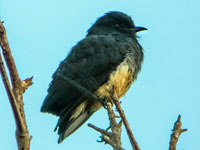
Genus Hapaloptila - 1 species
Nunbird, White-faced Hapaloptila castanea
Description: The white-faced nunbird, also known as white-faced puffbird, has brown upperparts. It has a grey-brown crown, white face and forehead outlined in black, plus a white throat. The bill is black, long and heavy; the eyes are red.
Range: Columbia, Ecuador, Peru.
Habitat: Forest, forest edges, steep slopes.
Diet: Mainly insects; also lizards, chicks.
Conservation status: Least Concern.
Image by: 1, 2) Nick Athanas - EcuadorRange: Columbia, Ecuador, Peru.
Habitat: Forest, forest edges, steep slopes.
Diet: Mainly insects; also lizards, chicks.
Conservation status: Least Concern.
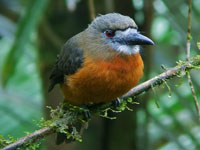
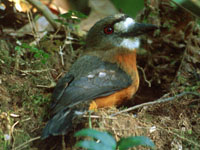
Genus Hypnelus - 1 species
Puffbird,_Russet-throated Hypnelus ruficollis
Description: The russet-throated puffbird has brown upperparts with small-whitish spots, a dark brown crown, and a mainly white face. The throat can be russet or whitish. It has a thick black hooked-tip bill. The underparts are whitish with one or two black beast bands. The russet-throated puffbird is 22 cm long and weighs 40 to 55 grams.
Range: Columbia, Venezuela
Habitat:: Forest openings and edges, grassland or scrubland with some trees.
Diet: Mainly insects; also lizards, fruit. Hunts from a perch, then flies to the ground, vegetation, or a branch for the prey.
Conservation status: Least Concern.
Image by: 1) Barloventomagico - Venezuela 2) Laura Gooch - Venezuela 3, 4) Nick Athanas - ColumbiaRange: Columbia, Venezuela
Habitat:: Forest openings and edges, grassland or scrubland with some trees.
Diet: Mainly insects; also lizards, fruit. Hunts from a perch, then flies to the ground, vegetation, or a branch for the prey.
Conservation status: Least Concern.

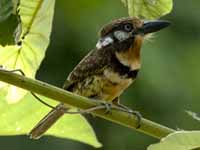
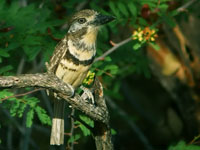

Genus Malacoptila
Puffbird,_Black-streaked Malacoptila fulvogularis
Description: The black-streaked puffbird has dark brown upperparts, a blackish head with white streaks, a brownish-yellow upper-breast patch, and heavily streaked underparts.
Range: Bolivia, Brazil, Ecuador, Peru.
Habitat: Forests, open woodland.
Diet: Insects and other invertebrates. Forages from a perch to leaves and branches. Also follows swarms of army ants.
Conservation status: Least Concern.
Image by: 1) Joseph Wolf 2) thibaudaronson 3) Nick Athanas - EcuadorRange: Bolivia, Brazil, Ecuador, Peru.
Habitat: Forests, open woodland.
Diet: Insects and other invertebrates. Forages from a perch to leaves and branches. Also follows swarms of army ants.
Conservation status: Least Concern.
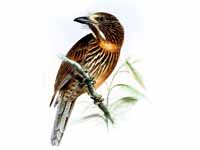
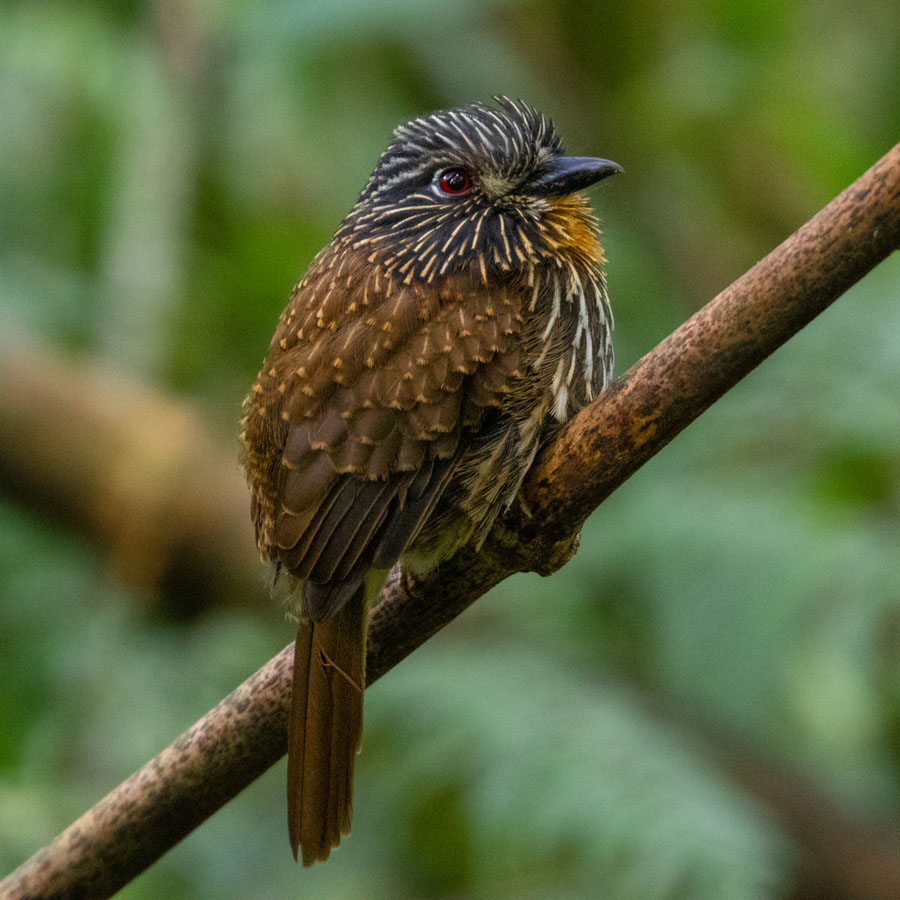
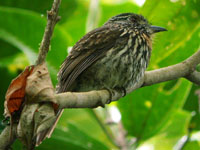
Puffbird,_Crescent-chested Malacoptila striata
Description: The crescent-chested puffbird has brown upperparts with streaking on head and upperparts. The upper-breast has a white crescent with a black band below it. The lower breast is rufous, the center of the belly whitish, and the sides of the breast and belly dull brown with buffy scallops. The crescent-chested puffbird is 17 to 20 cm long.
Range: Brazil.
Habitat: Forest edges, logged forests.
Diet: Mainly invertebrates.
Conservation status: Least Concern.
Image by: 1) Carlos_Henrique - Brazil 2) Dario Sanches - Brazil 3) Claudio Timm 4) Brendan_Ryan Range: Brazil.
Habitat: Forest edges, logged forests.
Diet: Mainly invertebrates.
Conservation status: Least Concern.

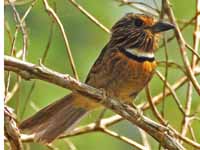
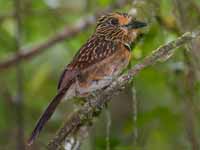
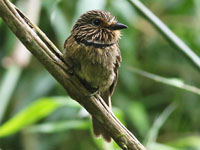
Puffbird,_Moustached Malacoptila mystacalis
Description: The male moustached puffbird has has brown upperparts with whitish spots on the back and wing coverts. There are white lores and a half eye-ring. It has a rufous chin and throat plus a rufous breast with some dark steaks. The belly is white and the flanks brown. The similar female has greyer upperparts and a paler breast with heavier streaks. Both sexes have bristles around the base of the bill, and white "whiskers"leading to the moustache reference. They also have a small white forehead patch, a black bill, and red eyes. The moustached puffbird is 20 to 23 cm long. It excavates a nest-cavity in an earthen bank.
Range: Columbia, Venezuela; a little of northern Ecuador.
Habitat: Mainly the undergrowth of forests; also forest edges and open woodland.
Diet: Not listed.
Conservation status: Least Concern.
Image by:
1, 4) Julian Londono - Columbia 3) Ron Knight 4) Alejandro_TamayoRange: Columbia, Venezuela; a little of northern Ecuador.
Habitat: Mainly the undergrowth of forests; also forest edges and open woodland.
Diet: Not listed.
Conservation status: Least Concern.
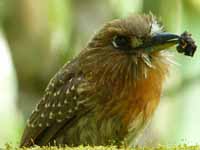
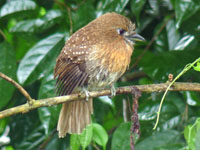
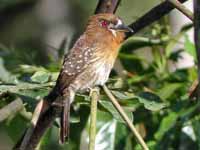
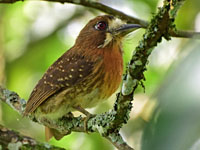
Puffbird,_Rufous-necked Malacoptila rufa Found: Bolivia, Brazil, Peru
Description: The rufous-naped puffbird has brown upperparts, a grey crown, and a rufous rear-collar plus lores. Unlike most puffbirds, the rufous-necked has no streaks. The underparts are tawny to pale. The rufous-naped puffbird is about 18 cm long.
Range: Northeast Bolivia, northeast Peru, and western Brazil.
Habitat: Forests.
Diet: Insects, other invertebrates. Flies from a perch to the ground or vegetation for its prey.
Conservation status: Least Concern.
Image by: 1) Gonzo_Lubitsch 2) Nick Athanas - BrazilRange: Northeast Bolivia, northeast Peru, and western Brazil.
Habitat: Forests.
Diet: Insects, other invertebrates. Flies from a perch to the ground or vegetation for its prey.
Conservation status: Least Concern.
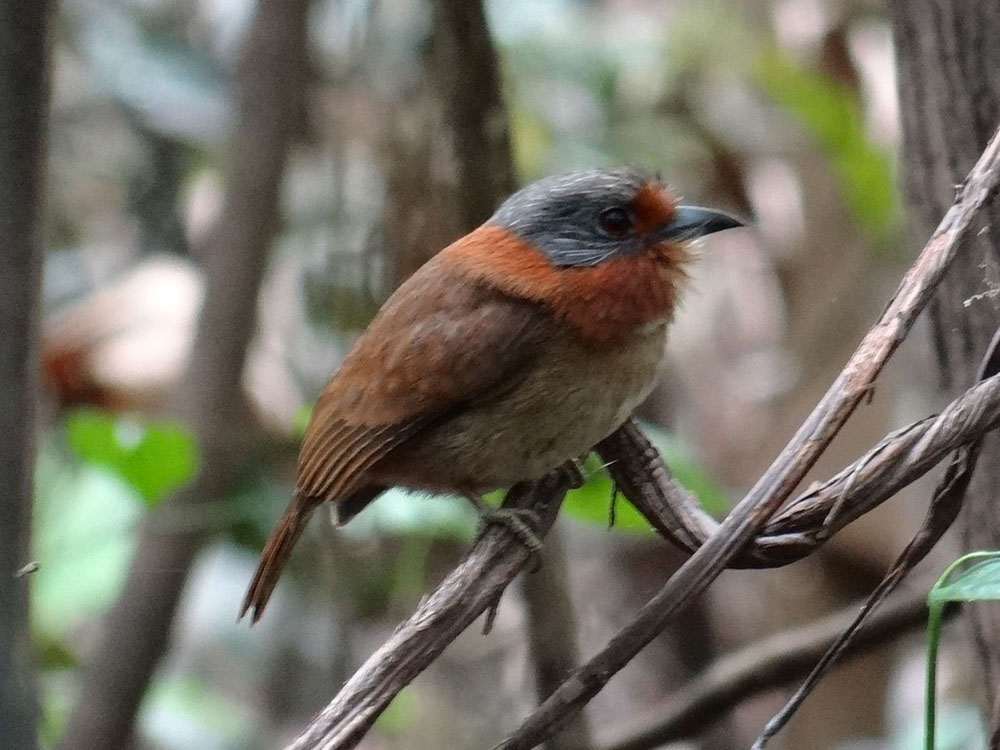

Puffbird,_Semicollared Malacoptila semicincta
Description: The semicollared puffbird has dark brown upperparts with whitish streaking. It has a blackish head with white lores and a rufous rear-collar. The buffy underparts have dark streaking - especially over the breast. It has an orange-yellow bill.
Range: Northwest Bolivia, western Brazil, southeast Peru.
Habitat: Forest edges, secondary forests.
Diet: Unknown.
Conservation status: Least Concern.
Image by: 1) Vil Sandi - Peru 2) Jenny_VilloneRange: Northwest Bolivia, western Brazil, southeast Peru.
Habitat: Forest edges, secondary forests.
Diet: Unknown.
Conservation status: Least Concern.
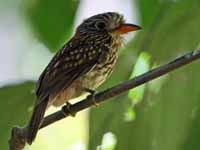

Puffbird,_White-chested Malacoptila fusca
Description: The white-chested puffbird has a white breast-patch, but it is usually not visible. It has buffy spots / streaking on dark upperparts, an orange bill with a black tip, pale lores, and pale underparts with brown streaks. The white-chested puffbird is about 19 cm long and weighs about 40 grams.
Range: Brazil, Columbia, Ecuador, the Guianas, Peru, Venezuela.
Habitat: Forest understory.
Diet: Flies from a perch to the ground or vegetation for its prey.
Conservation status: Least Concern.
Image by: 1) Don Faulkner - Ecuador 2) Nick Athanas - EcuadorRange: Brazil, Columbia, Ecuador, the Guianas, Peru, Venezuela.
Habitat: Forest understory.
Diet: Flies from a perch to the ground or vegetation for its prey.
Conservation status: Least Concern.
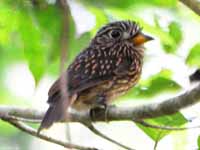

Puffbird,_White-whiskered Malacoptila panamensis
Description: The white-whiskered puffbird has mainly chestnut-brown upperparts with buff spots. It has a brown head with white wiskers on the face. The underparts are buffy white with dark steaking. It has a dark bill. The female has less obvious chestnut on the upperparts. The white-whiskered puffbird is 18 cm long. Nest cavities are created by burrowing into the ground.
Range: Mexico through Central America to Columbia, Ecuador, Peru.
Habitat: Mainly evergreen forests; also secondary forests and the edges of fields.
Diet: Watches from a perch for frogs, lizards, and large insects which it darts to capture.
Conservation status: Least Concern.
Image by: 1) Francesco Veronesi - Panama 2) Aaron_Maizlish -
Panama 3) Nick Athanas - PanamaRange: Mexico through Central America to Columbia, Ecuador, Peru.
Habitat: Mainly evergreen forests; also secondary forests and the edges of fields.
Diet: Watches from a perch for frogs, lizards, and large insects which it darts to capture.
Conservation status: Least Concern.
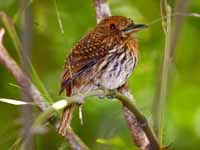
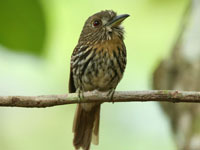
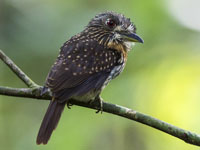
Genus Micromonacha - 1 species
Monklet, Lanceolated Micromonacha lanceolata
Description: The lanceolated monklet is a small puffbird that has chocolate-brown upperparts, black bordered white lores, and white underparts with thick black stripes. There is a white arc at the rear of the eyes. It is only 13 to 15 cm long and weighs 19 to 22 grams.
Range: Bolivia, Brazil, Colombia, Costa Rica, Ecuador, Panama, and Peru.
Habitat: Edges and clearings of woodlands, small forest patches, coffee plantations.
Diet: Insect and caterpillars which are captured on the ground after being spotted from a tree perch.
Conservation status: Least Concern.
Image by: 1) Joel Rosentha - Peru 2, 3) Nick Athanas - EcuadorRange: Bolivia, Brazil, Colombia, Costa Rica, Ecuador, Panama, and Peru.
Habitat: Edges and clearings of woodlands, small forest patches, coffee plantations.
Diet: Insect and caterpillars which are captured on the ground after being spotted from a tree perch.
Conservation status: Least Concern.
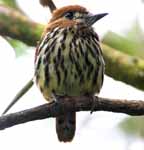
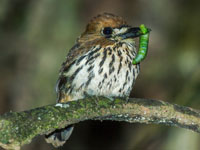
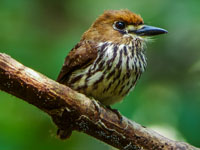
Genus Monasa
Nunbirds are larger than typical puffbirds, have a more slender appearance, and proportionately longer tail and smaller head. They are 25 to 29 cm long and weigh 40 to 100 grams. They have grey or black plumage which leads to their nunbird names. Insects are their main found and they are captured by sallies from a perch. They occur in or near thick forests from Nicaragua to Brazil. Their nest tunnels are over a meter long. Nunbirds. the most social of puffbirds, sometimes sing together as a group. Also, older siblings may help raise the young.
Nunbird, Black Monasa atra
Description: The black nunbird has glossy black upperparts, white shoulder area, red bill, and paler grey underparts. It is 25 to 29 cm long and weighs 75 to 100 grams. It has its nest in an earthen hole. The similar yellow-billed nunbird has yellow bill while the black nunbird has a red bill.
Range: Brazil, Columbia, the Guianas, Venezuela.
Habitat: Forest edges, near water, and in somewhat open landscapes.
Diet: Insects, other invertebrates, lizards. Sallies from a perch catching prey on a limb, vegetation, or sometimes in flight.
Conservation status: Least Concern.
Image by: 1) Dave Curtis - Guyana 2) Jerry Oldenettel - Venezuela 3) Nick Athanas - VenezuelaRange: Brazil, Columbia, the Guianas, Venezuela.
Habitat: Forest edges, near water, and in somewhat open landscapes.
Diet: Insects, other invertebrates, lizards. Sallies from a perch catching prey on a limb, vegetation, or sometimes in flight.
Conservation status: Least Concern.
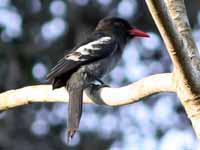

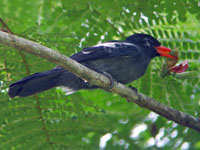
Nunbird, Black-fronted Monasa nigrifrons
Description: The black-fronted nunbird has all black plumage, reddish-orange bill and black legs. It is 26 to 29 cm long and weighs 70 to 100 grams. It excavates a nest-cavity in bank or even flat ground.
Range: Bolivia, Brazil, Columbia, Ecuador, Peru.
Habitat: Trees and bamboo along the edges of rivers and lakes.
Diet: Insects, small lizards, amphibians. Takes prey mainly in flight, but also on foliage or on the ground.
Conservation status: Least Concern.
Image by: 1) Wagner Lemes 2) Charlie Westerinen - Peru 3) Cláudio Timm -
Brazil 4) Nick Athanas - BrazilRange: Bolivia, Brazil, Columbia, Ecuador, Peru.
Habitat: Trees and bamboo along the edges of rivers and lakes.
Diet: Insects, small lizards, amphibians. Takes prey mainly in flight, but also on foliage or on the ground.
Conservation status: Least Concern.
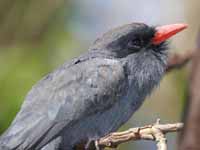
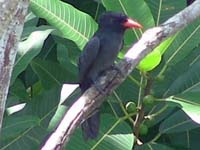
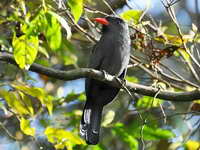
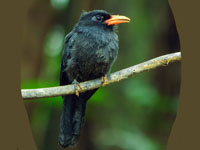
Nunbird, White-fronted Monasa morphoeus
Description: The white-fronted nunbird has all greyish-black plumage except a white forehead and chin. It has an orange bill and black legs. Its length at 21 to 29 cm varies considerably across the subspecies. It creates a nest-chambered, lined with leaves, at the end of an excavated tunnel.
Range: Bolivia, Brazil, Colombia, Costa Rica, Ecuador, Honduras, Nicaragua, Panama, Peru, and Venezuela.
Habitat: Forests, partially logged areas, cacao plantations.
Diet: Insects, other invertebrates, small lizards, amphibians. Also fruit.
Conservation status: Least Concern.
Image by: 1) David Cook - Ecuador 2) Nick Athanas _ Ecuador 3) gailhampshire - PanamaRange: Bolivia, Brazil, Colombia, Costa Rica, Ecuador, Honduras, Nicaragua, Panama, Peru, and Venezuela.
Habitat: Forests, partially logged areas, cacao plantations.
Diet: Insects, other invertebrates, small lizards, amphibians. Also fruit.
Conservation status: Least Concern.
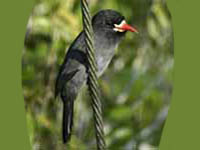
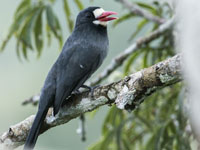
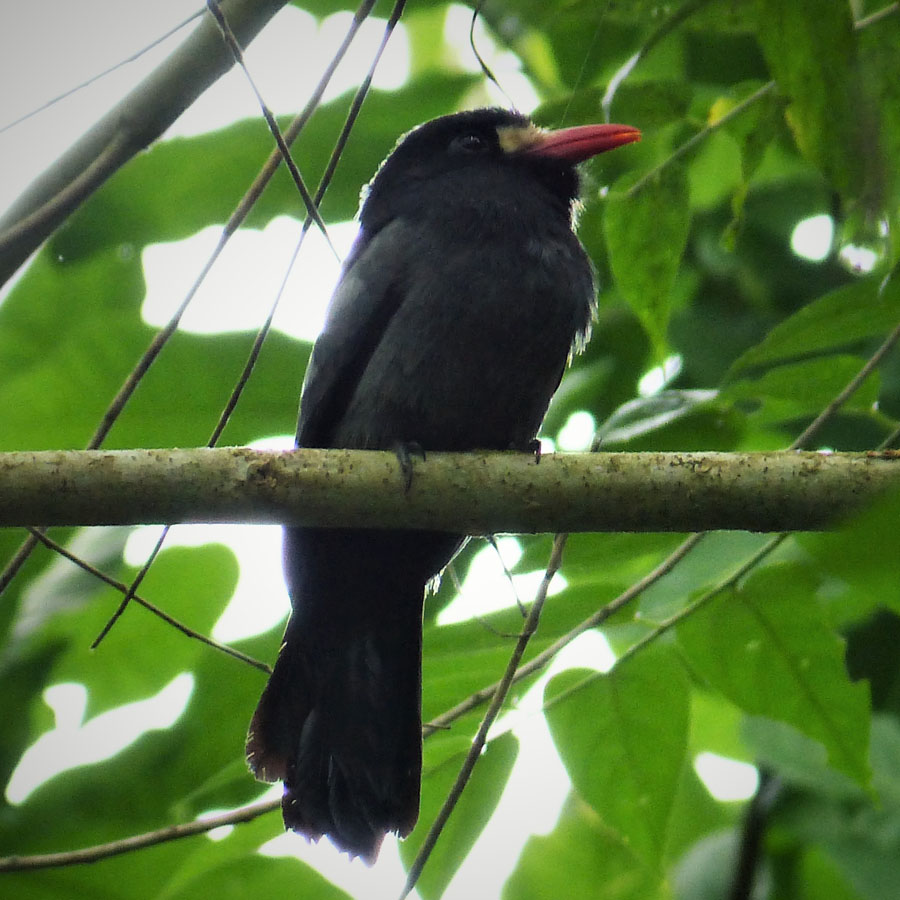
Nunbird, Yellow-billed Monasa flavirostris
Description: The yellow-billed nunbird has mainly black plumage, white on the shoulder region, and a yellow bill. The yellow-billed nunbird is 23 to 25 cm long and weights about 39 grams. It is similar to the black nunbird which has a red bill.
Range: Northern Bolivia, western Brazil, southeast Colombia, Ecuador, and Peru.
Habitat: Secondary forests, forest edges.
Diet: Mostly insects which it hunts by sallies from a high exposed perch.
Conservation status: Least Concern.
Image by: 1) Patty_McGann - Ecuador 2) Nick Athanas - EcuadorRange: Northern Bolivia, western Brazil, southeast Colombia, Ecuador, and Peru.
Habitat: Secondary forests, forest edges.
Diet: Mostly insects which it hunts by sallies from a high exposed perch.
Conservation status: Least Concern.
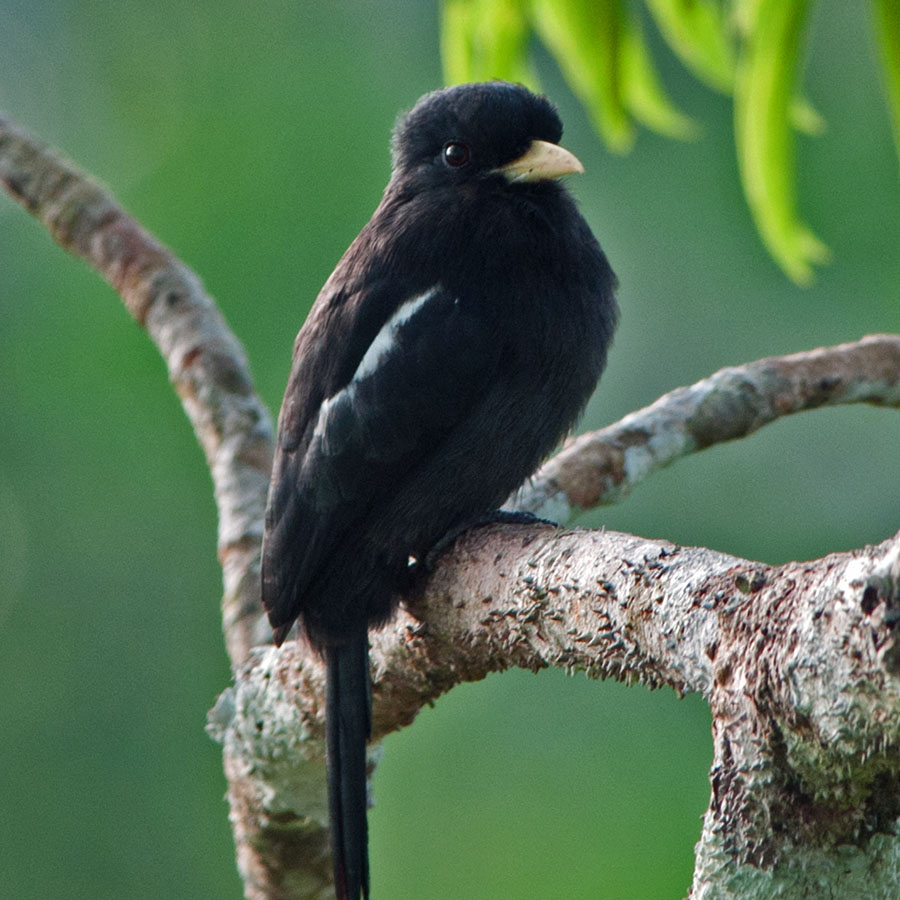
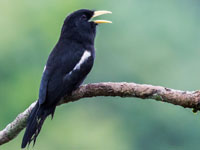
Genus Nonnula
The nunlets are generally unobtrusive species that do not sing frequently, and this undoubtedly affects our perceptions of their scarcity. They are the smallest of the puffbirds, with lengths from 14 to 15 cm and weighs between 15 and to grams.
Nunlet,_Brown Nonnula brunnea
Description: The brown nunlet has plain brown upperparts and crown. It has greyish-brown ear-coverts and a faint buffy eye-ring. The underparts are rufous. The brown nunlet is 14 to 15 cm long. It presumedly nest in a ground scrape which is covered with twigs and leaves.
Range: Columbia, Ecuador, Peru.
Habitat: Primary forest, dense secondary forest.
Diet: Unknown.
Conservation status: Least Concern.
Image by: 1) Nick Athanas - Ecuador Range: Columbia, Ecuador, Peru.
Habitat: Primary forest, dense secondary forest.
Diet: Unknown.
Conservation status: Least Concern.
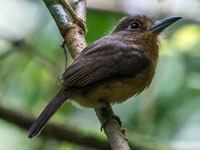
Nunlet, Gray-cheeked Nonnula frontalis
Description: The grey-cheeked nunlet has plain brown upperparts, lighter on the rump. It has a dark chestnut crown and a mostly grey face. The chin, throat, breast, and flanks are rufous and the belly is buffy. It has a blue-grey bill. The grey-cheeked nunlet is 14 to 15 cm long and weighs 15 to 20 grams.
Range: Columbia, Panama.
Habitat: Primary and secondary forests, thickets, woodlands along rivers.
Diet: Insects and other invertebrates.
Conservation status: Least Concern.
Image by: 1) Tony_Castro - Panama 2) Jacksnipe1990 - PanamaRange: Columbia, Panama.
Habitat: Primary and secondary forests, thickets, woodlands along rivers.
Diet: Insects and other invertebrates.
Conservation status: Least Concern.
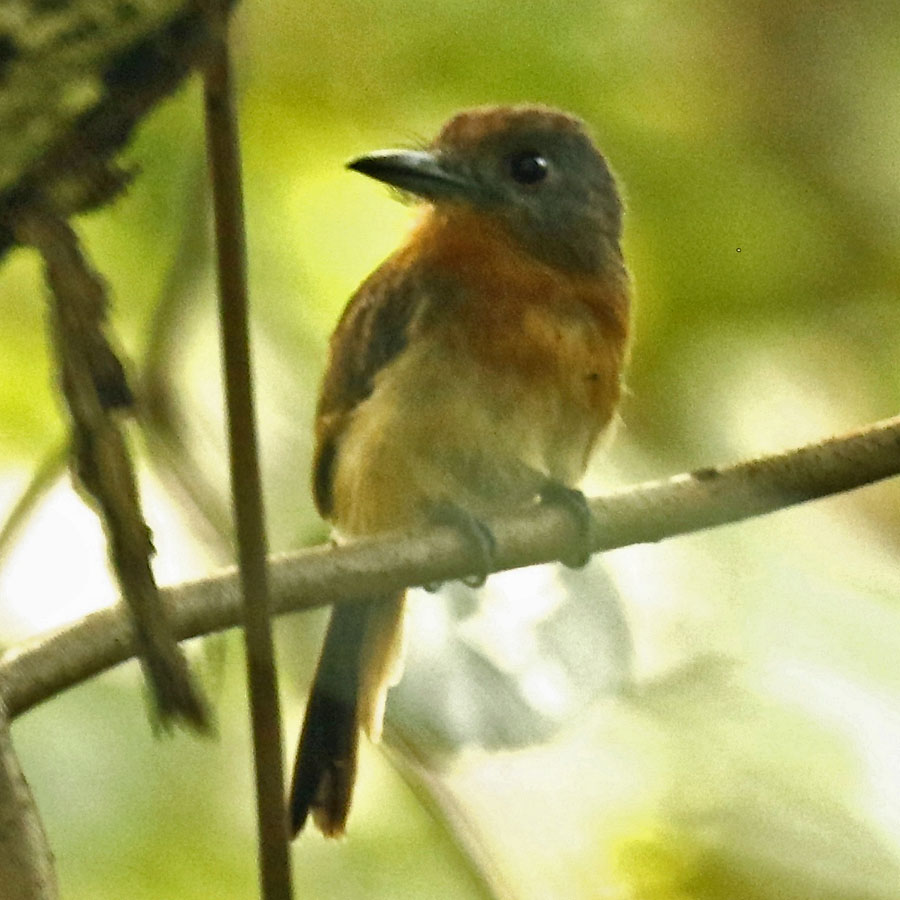
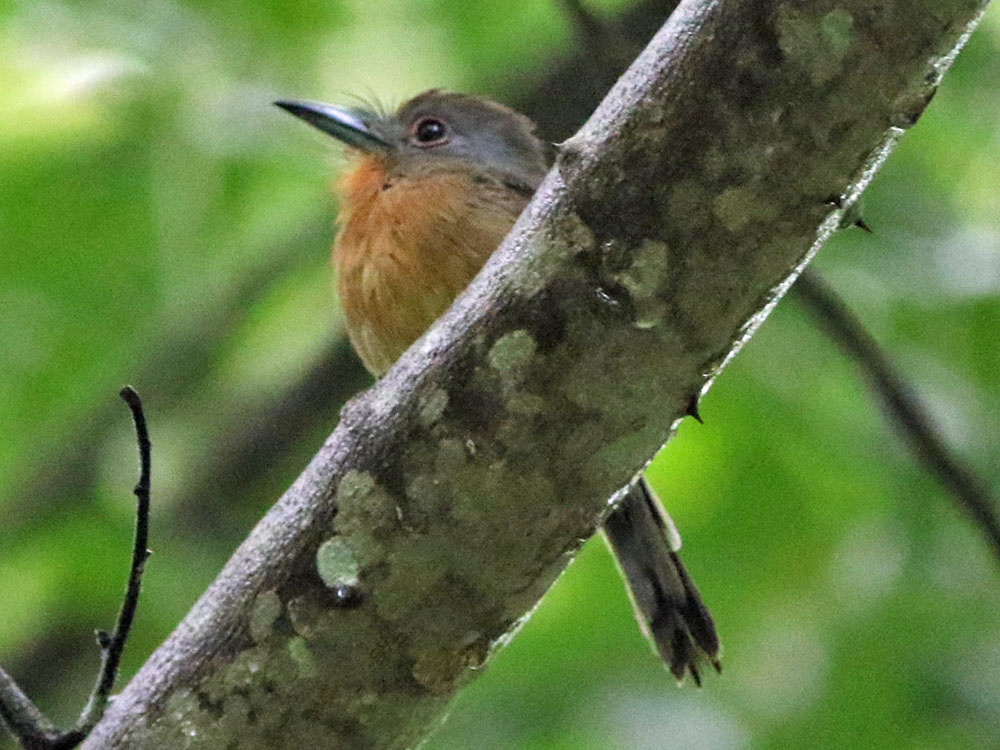
Nunlet, Rufous-capped Nonnula ruficapilla
Description: The rufous-capped nunlet has brown upperparts, a rufous cap, and lighter rufous underparts. It has blue-grey cheeks and neck. The rufous-capped nunlet is about 14 cm long and 15 to 20 grams.
Range: Bolivia, Brazil, Peru.
Habitat: The undergrowth of various forest types including along rivers.
Diet: Insects.
Conservation status: Least Concern.
Image by: 1) thibaudaronson Range: Bolivia, Brazil, Peru.
Habitat: The undergrowth of various forest types including along rivers.
Diet: Insects.
Conservation status: Least Concern.
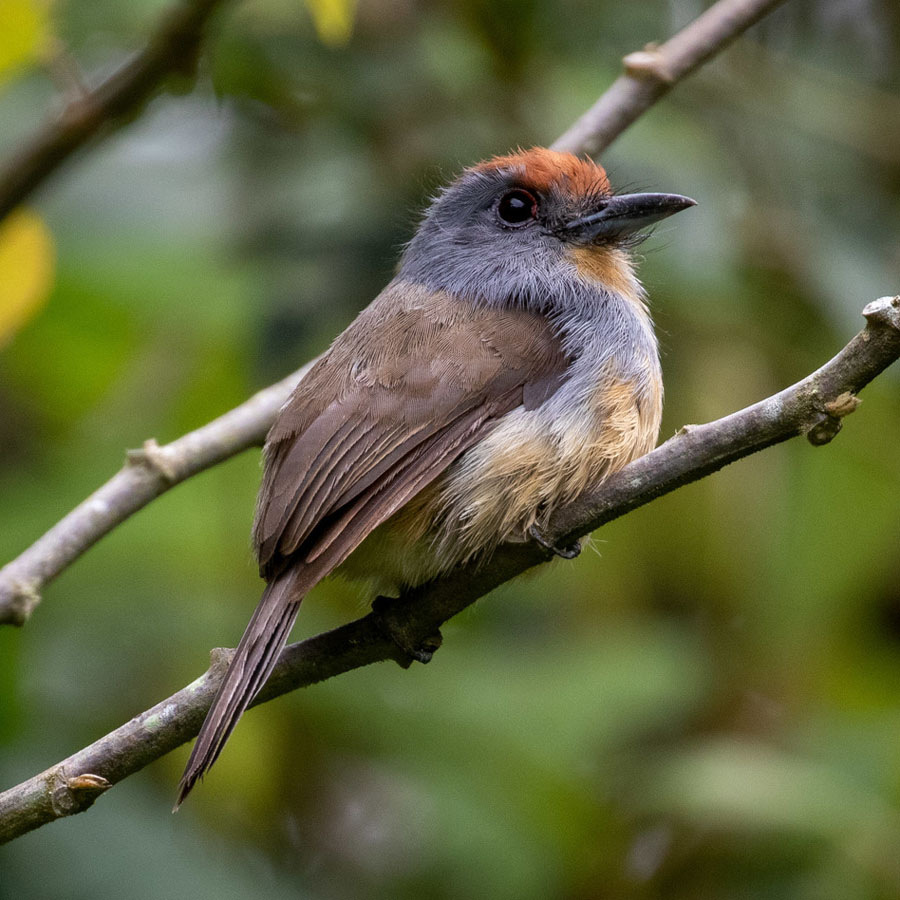
Nunlet, Rusty-breasted Nonnula rubecula Found: South America
Description: The rusty-breasted nunlet has mainly dull brown upperparts. It has a pale rufous throat and breast with a whitish belly There are white eye-ring and pale lores. The rusty-breasted nunlet is 14 rto 16 cm long and 17 to 20 grams. For its nest, it creates a ground scrape which is covered with twigs and leaves.
Range: It occurs ln two distinct regions - northern South America and southeastern Soutn America.
Habitat: Forest edges.
Diet: Insects, insect larvae, crabs.
Conservation status: Least Concern.
Image by: 1) Marco_Cruz - Brazil 2) Claudio Timm 3) Nick Athanas - BrazilRange: It occurs ln two distinct regions - northern South America and southeastern Soutn America.
Habitat: Forest edges.
Diet: Insects, insect larvae, crabs.
Conservation status: Least Concern.


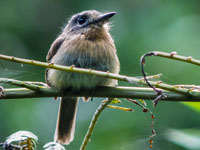
Genus Notharchus
These puffbirds all have black and white plumage.
Puffbird,_Black-breasted Notharchus pectoralis
Description: The black-breasted puffbird has black upperparts including the tail. The head is mostly black with a white arc on the nape and a white throat. ,It has black upper-breast, a white lower-breast, and the belly is also white. The black-breasted puffbird is 19 to 23 cm long. They nest in an aboreal termite mound. The similar pied puffbird has no white on its nape. The white-necked puffbird has a white forehead while the black-breasted puffbird has a black forehead.
Range: Columbia, Ecuador, Panama.
Habitat: Forest, not usually forest edges, near running water.
Diet: Centipedes and millipedes, scorpions, spiders, cockroaches, mantises, grasshoppers, beetles, and lizards. Dives from a perch to catch the prey then usually beats the catch on its perch to disable it.
Conservation status: Least Concern.
Image by: 1) Kb4003 - Panama 2) Sebastian Calle - Columbia 3) Nick Athanas - Panama 4) Charles_Sharp - PanamaRange: Columbia, Ecuador, Panama.
Habitat: Forest, not usually forest edges, near running water.
Diet: Centipedes and millipedes, scorpions, spiders, cockroaches, mantises, grasshoppers, beetles, and lizards. Dives from a perch to catch the prey then usually beats the catch on its perch to disable it.
Conservation status: Least Concern.
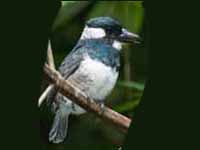
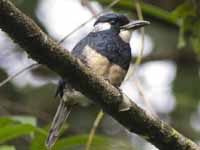
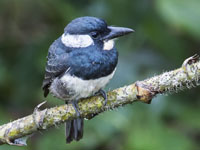
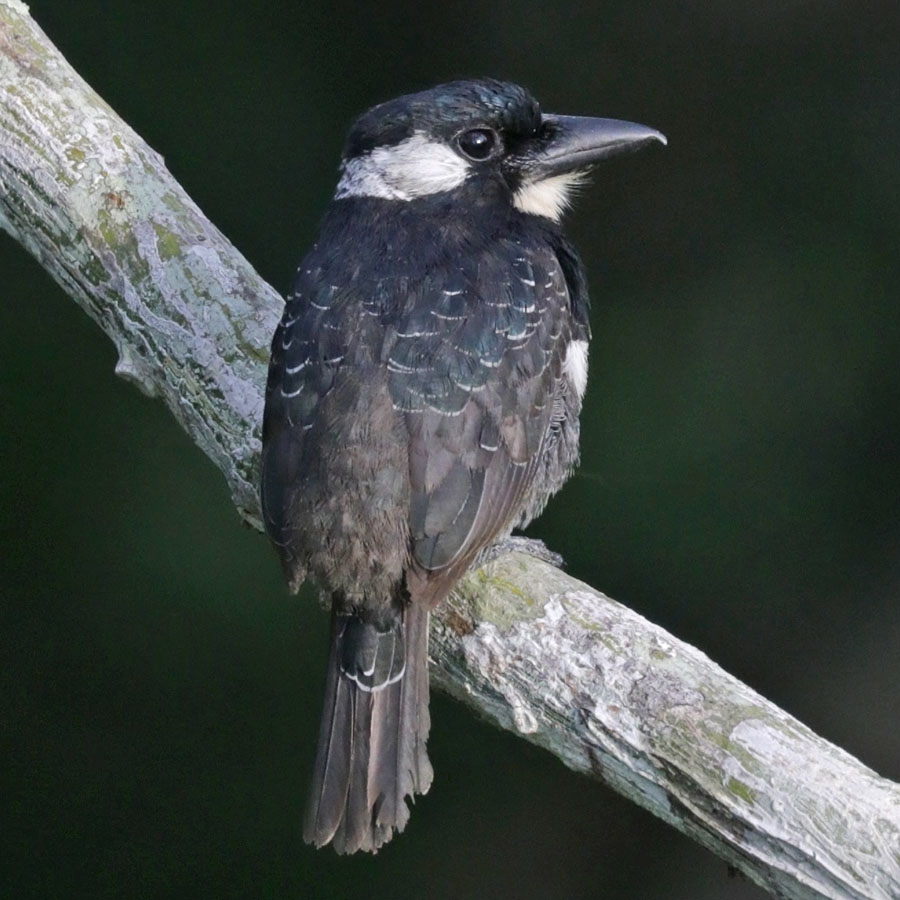
Puffbird,_Brown-banded Notharchus ordii
Description: The brown-banded puffbird has glossy black upperparts, crown, and nape. It has a white forehead, face, chin, throat, and upper-breast. A black band separates the white upper breast from the olive-brown lower breast. The belly is white with brown spots and the flanks are white with black spots. It has a black bill and black feet. The brown-banded puffbird is about 20 cm long and 50 grams of weight. It probably nests in an arboreal termite mound.
Range: Bolivia, Brazil, Peru, Venezuela.
Habitat: Forest, their edges, secondary forests, stunted forest on white-sand soils.
Diet: Probably flies from a perch to catch insects on the ground or vegetation.
Conservation status: Least Concern.
Image by:
1, 2) Nick Athanas - BrazilRange: Bolivia, Brazil, Peru, Venezuela.
Habitat: Forest, their edges, secondary forests, stunted forest on white-sand soils.
Diet: Probably flies from a perch to catch insects on the ground or vegetation.
Conservation status: Least Concern.

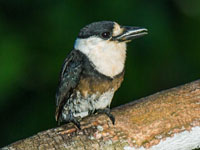
Puffbird,_Buff-bellied Notharchus swainsoni
Description: The buff-bellied puffbird has black upperparts and crown. It has a white neck, throat, and narrow white forehead. There is a black breast-band and the belly is buff. The buff-bellied puffbird is about 23 cm long and 75 cm of weight.
Range: Argentina, Brazil, and Paraguay.
Habitat: Lowland humid forest, and logged tall secondary forest.
Diet: Insects and their larvae, small vertebrates. Also fruit. It sallies from a high bare perch to grab its prey.
Conservation status: Least Concern.
Image by: 1, 2) Tony_Morris - Paraguay 3) Nick Athanas - BrazilRange: Argentina, Brazil, and Paraguay.
Habitat: Lowland humid forest, and logged tall secondary forest.
Diet: Insects and their larvae, small vertebrates. Also fruit. It sallies from a high bare perch to grab its prey.
Conservation status: Least Concern.
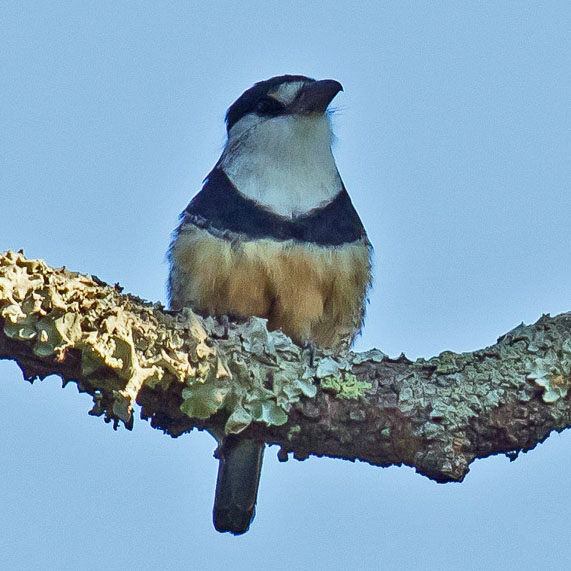
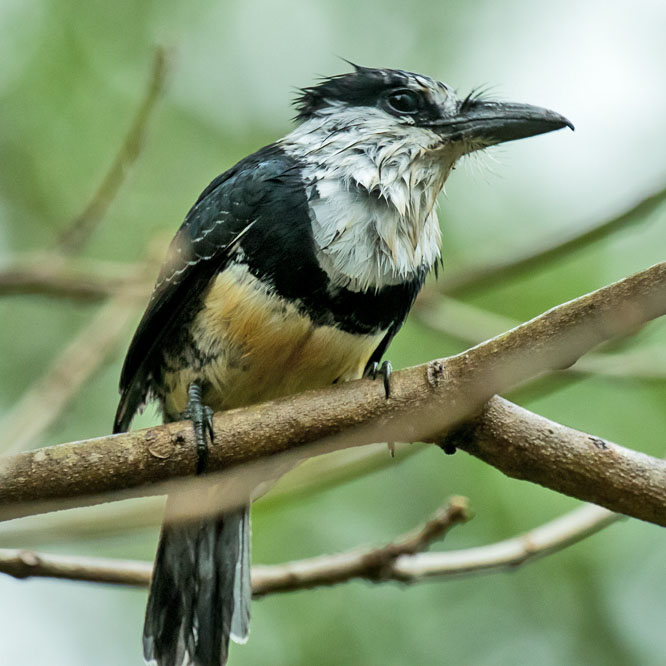
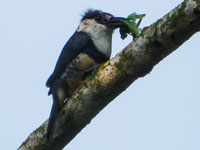
Puffbird,_Guianan Notharchus macrorhynchos
Description: The Guianan puffbird has black upperparts including a black crown. It has a white forehead and white underparts with a narrow black breast-band. The Guianan puffbird is 25 cm long and weighs 80 to 105 grams. It is similar to the white-necked puffbird which has a much larger white forehead patch.
Range: Northeastern Brazil, the Guianas, eastern Venezuela.
Habitat: Tropical forests - all levels from ground to the canopy.
Diet: Insects which it flies to from its perch to catch the prey on the wing or on vegetations. Usually brings the prey back to the same perch and beats it before eating.
Conservation status: Least Concern.
Image by: 1) Peter Bono - Brazil 2, 4) Hector_Bottai 3) Claudio_Timm - BrazilRange: Northeastern Brazil, the Guianas, eastern Venezuela.
Habitat: Tropical forests - all levels from ground to the canopy.
Diet: Insects which it flies to from its perch to catch the prey on the wing or on vegetations. Usually brings the prey back to the same perch and beats it before eating.
Conservation status: Least Concern.
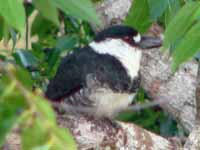
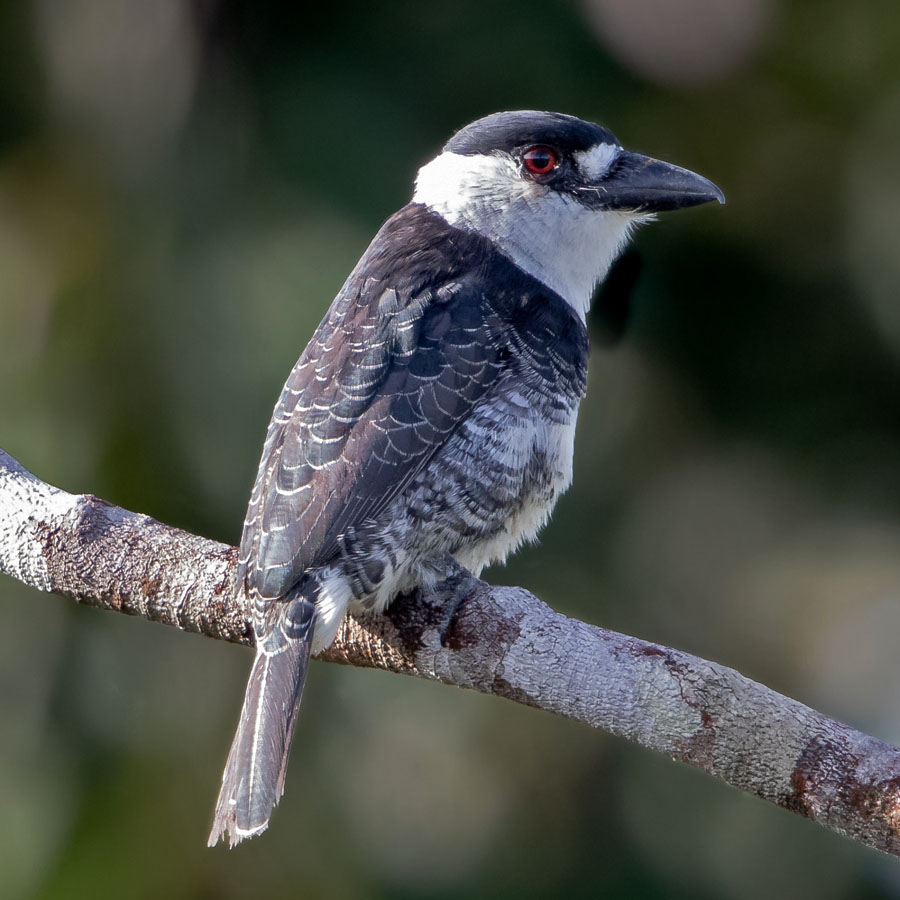
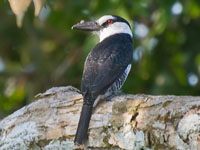
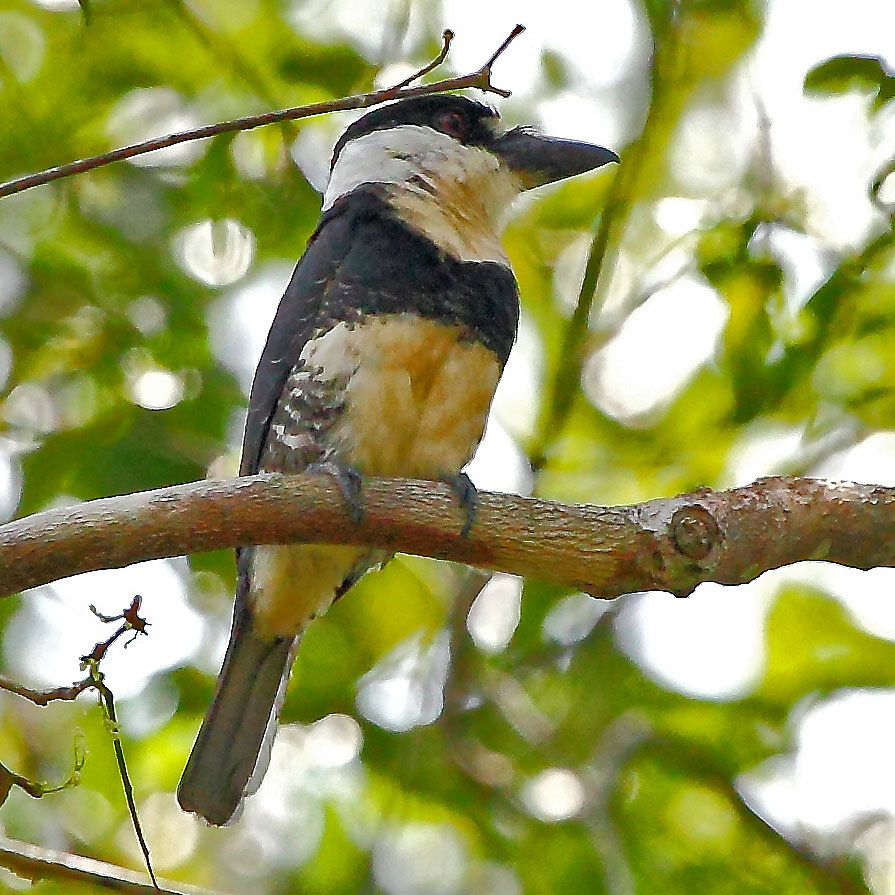
Puffbird,_Pied Notharchus tectus
Description: The pied puffbird has black upperparts with a white patch on the shoulders. It has , a black head with white freckles and a white eye-line. The underparts are white with a narrow black breast-band. The pied puffbird is 14 to 17 cm long. The nest is usually excavated in an arboreal termite mound. It is similar to the black-breasted puffbird which has a white arc on nape, while the pied puffbird has a black nape. The white-necked puffbird has a white forehead while the pied puffbird has a black forehead.
Range: Central Amercia to the middle of South America.
Habitat: Forests, secondary forests, clearing and edges, treed savana.
Diet: Insects, spiders and other anthropoids.
Conservation status: Least Concern.
Image by: 1) Sean McCann 2, 3) Dick Daniels - Soberania National Park, Panama 4) Nick Athanas - BrazilRange: Central Amercia to the middle of South America.
Habitat: Forests, secondary forests, clearing and edges, treed savana.
Diet: Insects, spiders and other anthropoids.
Conservation status: Least Concern.
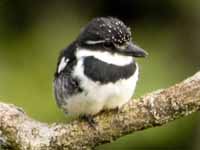



Puffbird,_White-necked Notharchus hyperrhynchus Found: Columbia, Ecuador, Panama
Description: The white-necked puffbird has black upperparts with white scallops. The head is mainly white with a small black cap and a black eye-line that extends to the cap. It has a white neck including the chin and throat. The underparts are also white with a wide black breast-band and black barring on the flanks. The white-necked puffbird is about 25 cm long. It creates a nest-cavity in an arboreal termite mound or rotting tree trunk. The similar black-breasted puffbird and pied puffbird both have black foreheads while the white-necked puffbird haa a white forehead,
Range: Southern Mexico and much of northern and central South America.
Habitat: Forest edges, open woodlands, treed savanna.
Diet: Mainly insects. Also other invertebrates and fruit. It dives from a perch to catch its prey, returns to said perch and beats the prey on the perch.
Conservation status: Least Concern.
Image by: 1) Jerry Kirkhart - Belize 2) Rob_Batchelder - Nicaragua 3) Nick Athanas - PanamaRange: Southern Mexico and much of northern and central South America.
Habitat: Forest edges, open woodlands, treed savanna.
Diet: Mainly insects. Also other invertebrates and fruit. It dives from a perch to catch its prey, returns to said perch and beats the prey on the perch.
Conservation status: Least Concern.
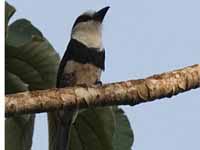
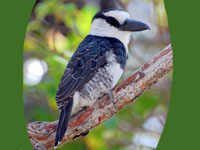
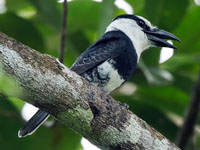
Genus Nystalus
Puffbird,_Barred Nystalus radiatus
Description: The barred puffbird has dark rufous upperparts and tail with black barring. The crown is black with some rufous bars. The nape and face are light rufous with thin black bars. Similarly, the underparts are light rufous with some fine black barring on the breast. It has yellowish eyes and grey legs. The barred puffbird is about 22 cm long and 65 grams. It excavates its nest chamber in a banking to a depth of about 1 meter.
Range: Central Panama through western Columbia into western Ecuador.
Habitat: Open areas with trees nearby.
Diet: Large insects, small lizards. Sallies from a perch to catch the prey.
Conservation status: Least Concern.
Image by: 1, 2) Dave Curtis - Panama 3) Felix_Uribe - ColumbiaRange: Central Panama through western Columbia into western Ecuador.
Habitat: Open areas with trees nearby.
Diet: Large insects, small lizards. Sallies from a perch to catch the prey.
Conservation status: Least Concern.

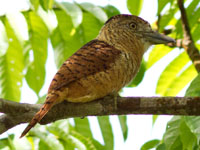
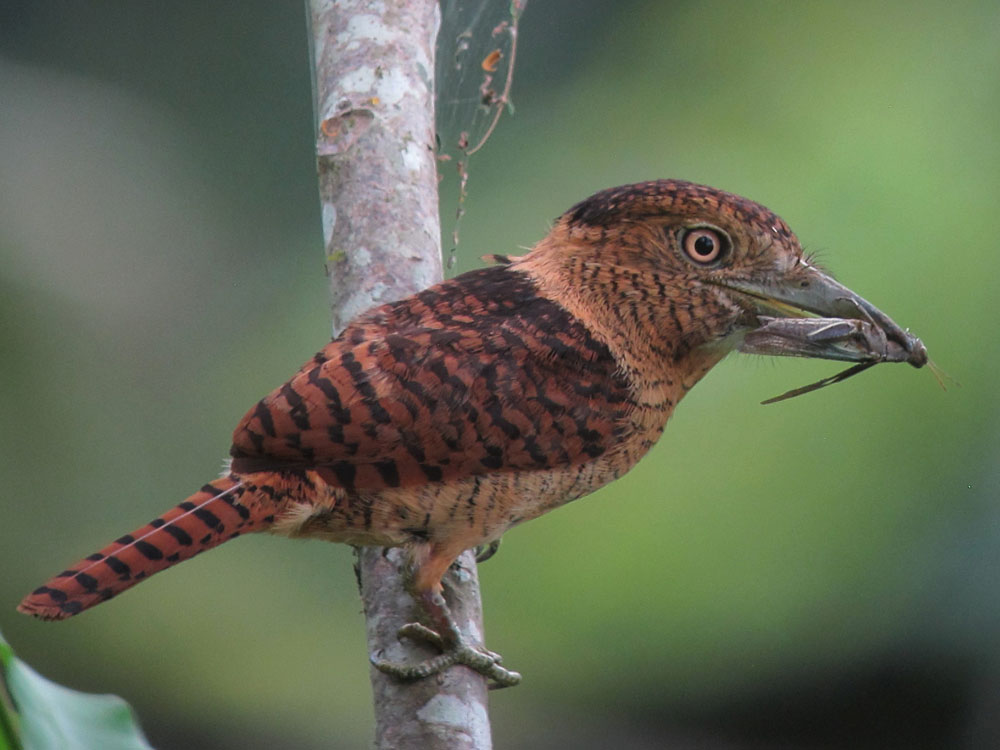
Puffbird,_Spot-backed Nystalus maculatus
Description: The spot-backed puffbird has buffy barred upperparts and a dark brown spotted crown. The throat and upper-breast are orange-rufous; the lower beast and flacks are pale with dark spots, the belly is white, and the bill is red. The "spot-backed" name refers to the barring on its pack which is formed by aligned spots. It is 18 to 19 cm long.
Range: Argentina, Bolivia, Brazil, Paraguay.
Habitat: Relatively open areas with trees available.
Diet: Mainly insects including caterpillars. It sallies from a low perch to capture prey on the ground or foliage.
Conservation status: Least Concern.
Image by: 1, 2) Dilson Santos - Brazil 2, 4) Nick Athanas - BrazilRange: Argentina, Bolivia, Brazil, Paraguay.
Habitat: Relatively open areas with trees available.
Diet: Mainly insects including caterpillars. It sallies from a low perch to capture prey on the ground or foliage.
Conservation status: Least Concern.
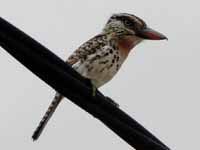

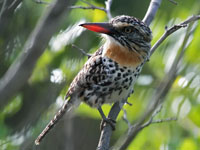

Puffbird,_Eastern_Striolated Nystalus striolatus
Description: The eastern striolated puffbird has dark brown upperparts with pale rufous marks. It has a dark brown crown, white lores, and white chin. The underparts are white with stripes. The eastern striolated puffbird is about 20 cm long. The eastern and western striolated puffbirds used to be conspecific. Some treat them as a single species, the striolated puffbird.
Range: Bolivia, Brazil.
Habitat: Forest edges, clearings, near water.
Diet: Grasshoppers, beetles, and other large arthropods. Also lizards.
Conservation status: Least Concern.
Image by: 1) Joseph Smit 2) Claudio Timm 3) Tony Castro Range: Bolivia, Brazil.
Habitat: Forest edges, clearings, near water.
Diet: Grasshoppers, beetles, and other large arthropods. Also lizards.
Conservation status: Least Concern.

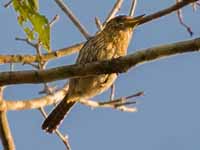
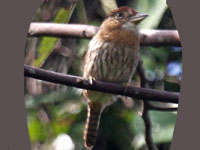
Puffbird,_Western Striolated Nystalus obamai Found: Bolivia, Columbia, Ecuador, Peru
Description: The westen striolated puffbird's scientific name was for President Obama. It has dark brown upperparts with pale rufous marks. It has a dark brown crown, white lores, and white chin. The underparts are white with stripes. The western striolated puffbird is about 20 cm long. The eastern and western striolated puffbirds used to be conspecific. Some treat them as a single species, the striolated puffbird.
Range: Bolivia, Ecuador, Peru, Brazil. Also, southeast Columbia. There is little overlap with the eastern striolated puffbird except in western Brazil.
Habitat: Forest edges, clearings, near water.
Diet: Grasshoppers, beetles, and other large arthropods. Also lizards.
Conservation status: Least Concern.
Image by: 1) Nick Athanas - Ecuador 2) Joao_QuentalRange: Bolivia, Ecuador, Peru, Brazil. Also, southeast Columbia. There is little overlap with the eastern striolated puffbird except in western Brazil.
Habitat: Forest edges, clearings, near water.
Diet: Grasshoppers, beetles, and other large arthropods. Also lizards.
Conservation status: Least Concern.
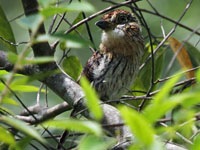

Puffbird,_White-eared Nystalus chacuru
Description: The white-eared puffbird has brown upperparts, wings, and crown. It has a white ear-patch surrounded by black. The bill is orange with a black tip. The underparts are mainly white with some dark scalloping on the breast and much more on the flanks. The white-eared puffbird is 21 to 22 cm long.
Range: Mainly Bolivia, Brazil, also Argentina, Paraguay.
Habitat: Forest edges, open woodlands, treed savanna.
Diet: Large insects, centipedes, other arthropods, and some invertebrates such as lizards. Captures prey on the ground and also in the air.
Conservation status: Least Concern.
Image by: 1) Egon_Fink 2) Claudio Timm 3) Dario Sanches - Brazil Range: Mainly Bolivia, Brazil, also Argentina, Paraguay.
Habitat: Forest edges, open woodlands, treed savanna.
Diet: Large insects, centipedes, other arthropods, and some invertebrates such as lizards. Captures prey on the ground and also in the air.
Conservation status: Least Concern.
